What is extra-virgin olive oil? Very simply: mechanically squeezed olive juice. Choosing a great product should be, at least in theory, a no-brainer: as in any other fruit juice, we would go for the freshest juice, made with the perfectly ripened – in this case, mostly still green – great quality olives….
But many aspects of production and storage can influence the final quality of the product.
Here is how to carefully read a label in order to select the best extra-virgin olive oil!
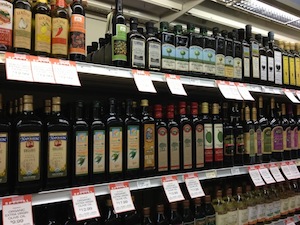 Label 101
Label 101
- Look at the production date: THE YOUNGER THE OIL, THE BETTER. The shelf life of an extra-virgin olive oil is on average about 2 years, better if 18 months (if stored properly). Not all bottles will show this fundamental information: in the US there is no law requiring an expiration date for EVOO, and when present, usually calculates 2 years of shelf life. Italy has just passed a law that requires producers to state the expiration date, set 18 months after production (note that olives in Italy are usually harvested from October to January). Choose an oil that states the expiration or (even better) the production date.
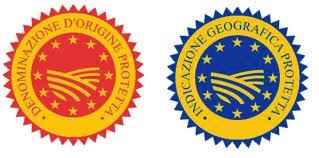 PREFER EUROPEAN OILS? CHOOSE PDO or IGP EXTRA-VIRGIN OLIVE OIL. Look for the red PDO or DOP seal on the label. DOP extra-virgin olive oil is the highest quality grade – a rare find – so no need to read the label further. You know it is an excellent product. It stands for Protected Designation of Origins – PDO in English – and means that everything in the production process is certified: from the variety and quality of the olives, to the cultivation and harvesting processes, to the grinding and extracting methods. The blue IGP or PGI seal (Indicazione Geografica Protetta, or Protected Geographical Indication) is also a nice designation, but only guarantees that the extra-virgin oil is at least partially prepared, processed or produced within a specific region.
PREFER EUROPEAN OILS? CHOOSE PDO or IGP EXTRA-VIRGIN OLIVE OIL. Look for the red PDO or DOP seal on the label. DOP extra-virgin olive oil is the highest quality grade – a rare find – so no need to read the label further. You know it is an excellent product. It stands for Protected Designation of Origins – PDO in English – and means that everything in the production process is certified: from the variety and quality of the olives, to the cultivation and harvesting processes, to the grinding and extracting methods. The blue IGP or PGI seal (Indicazione Geografica Protetta, or Protected Geographical Indication) is also a nice designation, but only guarantees that the extra-virgin oil is at least partially prepared, processed or produced within a specific region.- PREFER ITALIAN EXTRA-VIRGIN? CHECK THE ORIGIN: For US law, “product of XX” refers to the origin of the oil(s), while “imported from XX” or “Packed in XX” refers to where the oil was bottled.
Europe also has recently introduced a law that requires the label to clarify the origin of extra-virgin olive oil. Carefully check if the bottler is also the oil producer. It should say something like “produced in Italy” or “produced in Italy with olives coming from X country.” In this second case, the oil may have been packed in Italy with oils coming from other countries, and therefore may not be “Italian” – no matter how Italian-sounding the brand. 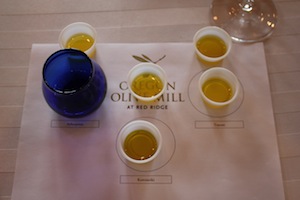 TASTE: First of all, a quality extra-virgin olive oil does have a distinctive taste. In fact, during the mandatory IOC (International Olive Council) tasting examination, for an oil to be graded as extra-virgin, it must have zero defects in taste and smell and more than zero in the fruity attribute. The extra-virgin can be reminiscent of almond, grass, pear, artichoke, tomato leaves… and many others flavors! The truth is that while the best olio nuovo has plenty of these positive attributes, they will eventually vanish over time. One of the most volatile characteristics of freshly squeezed oil (and usually an indication of a great product) is being pungent and peppery. A bland, totally flat-tasting extra-virgin olive oil may please a majority of consumers overall, but it’s not what excellence is about. Different olive varieties (cultivars) have distinctive flavors. As in wine and grapes, weather can influence the quality of olives coming from the exact same trees from one year to the next. Also like wine, bottles may contain a blend of varieties, so tasting is a really good way to understand what you like the best. For example, I prefer strongly flavored cultivars from the south of Italy.
TASTE: First of all, a quality extra-virgin olive oil does have a distinctive taste. In fact, during the mandatory IOC (International Olive Council) tasting examination, for an oil to be graded as extra-virgin, it must have zero defects in taste and smell and more than zero in the fruity attribute. The extra-virgin can be reminiscent of almond, grass, pear, artichoke, tomato leaves… and many others flavors! The truth is that while the best olio nuovo has plenty of these positive attributes, they will eventually vanish over time. One of the most volatile characteristics of freshly squeezed oil (and usually an indication of a great product) is being pungent and peppery. A bland, totally flat-tasting extra-virgin olive oil may please a majority of consumers overall, but it’s not what excellence is about. Different olive varieties (cultivars) have distinctive flavors. As in wine and grapes, weather can influence the quality of olives coming from the exact same trees from one year to the next. Also like wine, bottles may contain a blend of varieties, so tasting is a really good way to understand what you like the best. For example, I prefer strongly flavored cultivars from the south of Italy.- For Italian oils, look for “prima spremitura a freddo” (COLD PRESS) or “estratto a freddo” (COLD-EXTRACTION) on the label, meaning that the olive grinding and stirring never raises the temperature above 27°C (80°F). This enhances the quality of the oil. “Prima spremitura a freddo” also means that the olive paste was pressed in the traditional method rather than being spun in a centrifuge.
- The terms “FIRST PRESS” or “prima spremitura” are meaningless and misleading since there is only one press.
- “UNFILTERED” extra-virgin olive oil has a cloudy appearance, a slightly stronger taste and a higher nutritional content. However, the cloudy particulates reduce the shelf life to just a few months, so make sure you are buying fresh oil. Also, it will have a lower smoking point for deep-frying.
- “ORGANIC” is nice if you like to limit chemicals. Recent research found that one in four olive oils has chemical residues.
- “LIGHT”: Light oil doesn’t exist. The taste might be mild, but please note that there is no difference in calories between oils – all of them, even seed ones – have 9 Kcal per gram.
- SEALS: Award seals can be tricky and sometimes misleading, so beware. A couple of meaningful American seals are the voluntary NAOOA (North American Olive Oil Association) and COOC (California Olive Oil Council). NAOOA members comply with Europe’s detailed standards, whereas the COOC seal is available only to California producers and includes fewer tests than the European analysis. But it is still a good seal to have. Anything produced in Europe, Northern Africa, much of the Middle East, Argentina and Uruguay is compliant with International Olive Council (IOC) rules that strictly regulate olive oil production and grading. The US is not a member of the IOC. In Europe, the best seal is the DOP, followed by IGP (see #2).
- OTHER INFORMATION may include oil acidity, olive cultivars and other taste-related characteristics. The lower the acidity, the better (extra-virgin must have no more than 0.8% in free acidity).
This buying guide is part of my iPhone app, so that you will be able to bring it with you while doing your grocery shopping.
RESOURCES:
Etichetta olio, quanto serve sapere
Ecco come realizzare un’etichetta per l’olio extravergine a prova di controlli

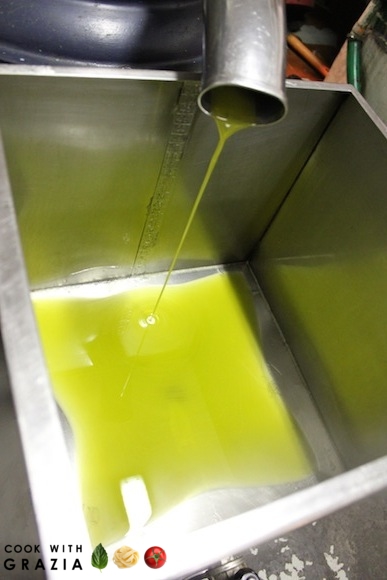
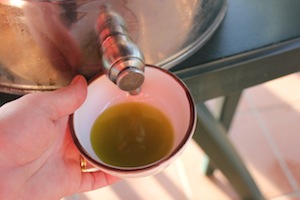
[…] taste to deep-fried foods, and, in my opinion, it’s also easiest on the stomach. Don’t use your best extra-virgin (dop for example) for deep-frying. A regular, not very expensive one will definitely do a wonderful job for deep […]
[…] It is a great dish to enhance the taste of newly pressed extra virgin olive oil, and it should be cooked only if you have some olio nuovo of the best quality in your hands (check here how to buy great Extra Virgin Olive Oil). […]
[…] for an EVOO that carries a PDO label (Protected Designation of Origin). You can read this helpful guide for more detailed […]
[…] for an EVOO that carries a PDO label (Protected Designation of Origin). You can read this helpful guide for more detailed […]